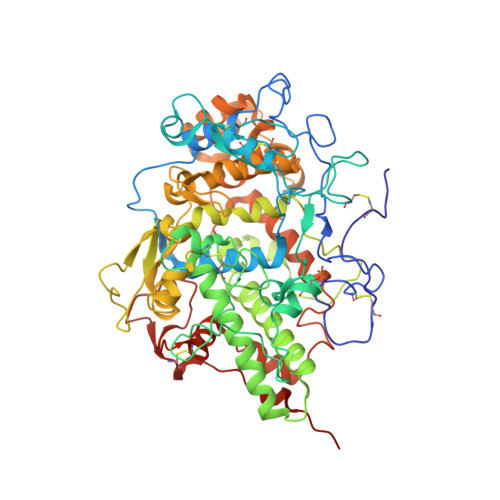Crystal Structure of Lactoperoxidase at 2.4 A Resolution.
Singh, A.K., Singh, N., Sharma, S., Singh, S.B., Kaur, P., Bhushan, A., Srinivasan, A., Singh, T.P.(2007) J Mol Biol 376: 1060-1075
- PubMed: 18191143
- DOI: https://doi.org/10.1016/j.jmb.2007.12.012
- Primary Citation of Related Structures:
2R5L - PubMed Abstract:
Lactoperoxidase (LPO) is a member of the mammalian peroxidase superfamily. It catalyzes the oxidation of thiocyanate and halides. Freshly isolated and purified samples of caprine LPO were saturated with ammonium iodide and crystallized using 20% polyethylene glycol 3350 in a hanging drop vapor diffusion setup. The structure has been determined using X-ray crystallographic method and refined to R(cryst) and R(free) factors of 0.196 and 0.203, respectively. The structure determination revealed an unexpected phosphorylation of Ser198 in LPO, which is also confirmed by anti-phosphoserine antibody binding studies. The structure is also notable for observing densities for glycan chains at all the four potential glycosylation sites. Caprine LPO consists of a single polypeptide chain of 595 amino acid residues and folds into an oval-shaped structure. The structure contains 20 well-defined alpha-helices of varying lengths including a helix, H(2a), unique to LPO, and two short antiparallel beta-strands. The structure confirms that the heme group is covalently linked to the protein through two ester linkages involving carboxylic groups of Glu258 and Asp108 and modified methyl groups of pyrrole rings A and C, respectively. The heme moiety is slightly distorted from planarity, but pyrrole ring B is distorted considerably. However, an iron atom is displaced only by 0.1 A from the plane of the heme group toward the proximal site. The substrate diffusing channel in LPO is cylindrical in shape with a diameter of approximately 6 A. Two histidine residues and six buried water molecules are connected through a hydrogen-bonded chain from the distal heme cavity to the surface of protein molecule and seemingly form the basis of proton relay for catalytic action. Ten iodide ions have been observed in the structure. Out of these, only one iodide ion is located in the distal heme cavity and is hydrogen bonded to the water molecule W1. W1 is also hydrogen bonded to the heme iron as well as to distal His109. The structure contains a calcium ion that is coordinated to seven oxygen atoms and forms a typical pentagonal bipyramidal coordination geometry.
Organizational Affiliation:
Department of Biophysics, All India Institute of Medical Sciences, Ansari Nagar, New Delhi - 110 029, India.




















